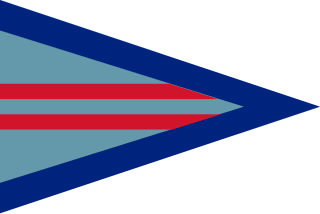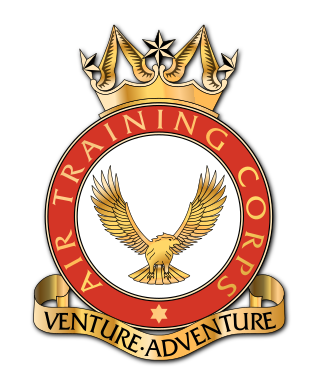Flying officer is a junior commissioned rank in the Royal Air Force (RAF) and the air forces of many countries which have historical British influence. It is also sometimes used as the English translation of an equivalent rank in countries which have a non-English air force-specific rank structure. In these cases a flying officer usually ranks above pilot officer and immediately below flight lieutenant.

Wing commander is a senior commissioned rank in the British Royal Air Force and air forces of many countries which have historical British influence, including many Commonwealth countries but not including Canada and South Africa. It is sometimes used as the English translation of an equivalent rank in countries which have a non-English air force-specific rank structure. It ranks immediately above squadron leader and immediately below group captain.

Group captain is a senior commissioned rank in the Royal Air Force, where it originated, as well as the air forces of many countries that have historical British influence. It is sometimes used as the English translation of an equivalent rank in countries which have a non-British air force-specific rank structure. Group captain has a NATO rank code of OF-5, meaning that it ranks above wing commander and immediately below air commodore, and is the equivalent of the rank of captain in the navy and of the rank of colonel in other services.

Air commodore is a senior rank in the air forces of the United Kingdom and other countries including Australia, New Zealand, India, Pakistan and Zimbabwe. It is a one-star rank and is an air officer rank. It originated in, and continues to be used by the Royal Air Force.
Flight lieutenant is a junior commissioned rank in air forces that use the Royal Air Force (RAF) system of ranks, especially in Commonwealth countries. It has a NATO rank code of OF-2. Flight lieutenant is abbreviated as Flt Lt in the Indian Air Force (IAF) and RAF, and as FLTLT in the Pakistan Air Force (PAF), Royal Australian Air Force (RAAF) and Royal New Zealand Air Force (RNZAF) and has sometimes also been abbreviated as F/L in many services; it has never been correctly abbreviated as "lieutenant". A flight lieutenant ranks above flying officer and below a squadron leader and is sometimes used as an English language translation of a similar rank in non-English-speaking countries.
Pilot officer is the lowest commissioned rank in the Royal Air Force and the air forces of many other Commonwealth countries. It ranks immediately below flying officer.

The Air Training Corps (ATC) is a British volunteer youth organisation of the United Kingdom; aligned to, and fostering the knowledge and learning of military values, primarily focussing on military aviation. Part of the Royal Air Force Air Cadets (RAFAC), the ATC is sponsored by the Royal Air Force (RAF) and the wider Ministry of Defence (MoD). The majority of Air Training Corps staff are volunteers, though some staff are paid for full-time work; including Commandant Air Cadets, who is a Royal Air Force officer as part of a Full Term Reserve Service commitment.
Officer Cadet is a rank held by military cadets during their training to become commissioned officers. In the United Kingdom, the rank is also used by members of University Royal Naval Units, University Officer Training Corps and University Air Squadron; however, these are not trainee officers with many not choosing a career in the armed forces.

Royal Air Force Cranwell or more simply RAF Cranwell is a Royal Air Force station in Lincolnshire, England, close to the village of Cranwell, near Sleaford. Among other functions, it is home to the Royal Air Force College (RAFC), which trains the RAF's new officers and aircrew. The motto, Altium Altrix, meaning "Nurture the highest" appears above the main doors of the Officers Mess. Since January 2023, RAF Cranwell has been commanded by Group Captain Tina Jessup.
University Air Squadrons are training units under the command of No. 6 Flying Training School RAF of the Royal Air Force and their main role is to attract students into careers as RAF officers. Primarily its goal is achieved through offering basic flying training, force development and adventure training to undergraduate students at British universities. These units exist to provide a taste of life in the Service and to give experience to their members in preparation for taking up a career as an officer in one of the RAF's many branches.
The officer ranks of the Royal Air Force, as they are today, were introduced in 1919. Prior to that Army ranks were used.
Before Unification as the Canadian Armed Forces in 1968, the Canadian military had three distinct services: the Royal Canadian Navy, the Royal Canadian Air Force, and the Canadian Army. All three services had a Regular (full-time) component and a reserve (part-time) component. The rank structure for these services were based on the services of the British military, the Royal Navy, the Royal Air Force, and the British Army. The change to a "Canadian" rank structure meant that many of the traditional (British) rank titles and insignia were removed or changed.
The Royal Air Force Volunteer Reserve (Training Branch), often abbreviated to RAFVR(T), was a Volunteer Reserve element of the Royal Air Force specifically appointed in a cadet training role within the Royal Air Force Volunteer Reserve. Members of the RAFVR(T) had no call-up liability and often operated part-time with the Air Experience Flights and Volunteer Gliding Squadrons, which provide flight experience for the Royal Air Force Air Cadets.
The Royal Air Force Volunteer Reserve (RAFVR) was established in 1936 to support the preparedness of the U.K. Royal Air Force in the event of another war. The Air Ministry intended it to form a supplement to the Royal Auxiliary Air Force (RAuxAF), the active reserve for the RAF, by providing an additional non-active reserve. However during the Second World War the high demand for aircrew absorbed all available RAuxAF personnel and led the RAFVR to quickly become the main pathway of aircrew entry into the RAF. It was initially composed of civilians recruited from neighbourhood reserve flying schools, run by civilian contractors with largely RAF-trained flying instructors as well as other instructors in related air war functions, such as observers and wireless operators.

The Royal Air Force uniform is the standardised military dress worn by members of the Royal Air Force. The predominant colours of Royal Air Force uniforms are blue-grey and Wedgwood blue. Many Commonwealth air forces' uniforms are also based on the RAF pattern, but with nationality shoulder flashes. The Royal Air Force Air Cadets wear similar uniforms.

The Royal Air Force College (RAFC) is the Royal Air Force military academy which provides initial training to all RAF personnel who are preparing to become commissioned officers. The College also provides initial training to aircrew cadets and is responsible for all RAF recruiting along with officer and aircrew selection. Originally established as a naval aviation training centre during World War I, the College was established as the world's first air academy in 1919. During World War II, the College was closed and its facilities were used as a flying training school. Reopening after the War, the College absorbed the Royal Air Force Technical College in 1966.

A warrant officer (WO) in the British Armed Forces is a member of the highest-ranking group of non-commissioned ranks, holding the King's Warrant, which is signed by the Secretary of State for Defence.
Cambridge University Air Squadron, abbreviated CUAS, formed in 1925, is the training unit of the Royal Air Force at the University of Cambridge and forms part of the Royal Air Force Volunteer Reserve. It is the oldest of 15 University Air Squadrons in the UK. For many years it was based at Cambridge Airport at Teversham.
The following table displays the ranks of the Community Cadet Forces, the Combined Cadet Force, the Volunteer Cadet Corps, and the Girls Venture Corps Air Cadets. This table is based on equivalent Rank Structures within the Cadet Forces as detailed in regulations of the SCC, RMC, and the Air Cadets.
The military ranks and insignia of Chile are the military insignia used by the Chilean Armed Forces.










